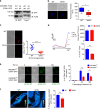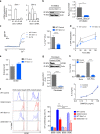UNC93B1 interacts with the calcium sensor STIM1 for efficient antigen cross-presentation in dendritic cells
- PMID: 29158474
- PMCID: PMC5696382
- DOI: 10.1038/s41467-017-01601-5
UNC93B1 interacts with the calcium sensor STIM1 for efficient antigen cross-presentation in dendritic cells
Abstract
Dendritic cells (DC) have the unique ability to present exogenous antigens via the major histocompatibility complex class I pathway to stimulate naive CD8+ T cells. In DCs with a non-functional mutation in Unc93b1 (3d mutation), endosomal acidification, phagosomal maturation, antigen degradation, antigen export to the cytosol and the function of the store-operated-Ca2+-entry regulator STIM1 are impaired. These defects result in compromised antigen cross-presentation and anti-tumor responses in 3d-mutated mice. Here, we show that UNC93B1 interacts with the calcium sensor STIM1 in the endoplasmic reticulum, a critical step for STIM1 oligomerization and activation. Expression of a constitutively active STIM1 mutant, which no longer binds UNC93B1, restores antigen degradation and cross-presentation in 3d-mutated DCs. Furthermore, ablation of STIM1 in mouse and human cells leads to a decrease in cross-presentation. Our data indicate that the UNC93B1 and STIM1 cooperation is important for calcium flux and antigen cross-presentation in DCs.
Conflict of interest statement
The authors declare no competing financial interests.
Figures








Similar articles
-
The mammalian trafficking chaperone protein UNC93B1 maintains the ER calcium sensor STIM1 in a dimeric state primed for translocation to the ER cortex.J Biol Chem. 2022 Mar;298(3):101607. doi: 10.1016/j.jbc.2022.101607. Epub 2022 Jan 20. J Biol Chem. 2022. PMID: 35065962 Free PMC article.
-
STIM1 promotes migration, phagosomal maturation and antigen cross-presentation in dendritic cells.Nat Commun. 2017 Nov 24;8(1):1852. doi: 10.1038/s41467-017-01600-6. Nat Commun. 2017. PMID: 29176619 Free PMC article.
-
Ca2+ Signaling but Not Store-Operated Ca2+ Entry Is Required for the Function of Macrophages and Dendritic Cells.J Immunol. 2015 Aug 1;195(3):1202-17. doi: 10.4049/jimmunol.1403013. Epub 2015 Jun 24. J Immunol. 2015. PMID: 26109647 Free PMC article.
-
Are ERAD components involved in cross-presentation?Mol Immunol. 2015 Dec;68(2 Pt A):112-5. doi: 10.1016/j.molimm.2015.05.002. Epub 2015 May 23. Mol Immunol. 2015. PMID: 26005101 Review.
-
Stromal interaction molecules as important therapeutic targets in diseases with dysregulated calcium flux.Biochim Biophys Acta. 2014 Oct;1843(10):2307-14. doi: 10.1016/j.bbamcr.2014.03.019. Epub 2014 Mar 25. Biochim Biophys Acta. 2014. PMID: 24681268 Review.
Cited by
-
Proteins Interacting with STIM1 and Store-Operated Ca2+ Entry.Prog Mol Subcell Biol. 2021;59:51-97. doi: 10.1007/978-3-030-67696-4_4. Prog Mol Subcell Biol. 2021. PMID: 34050862 Review.
-
Construction and validation of a transient receptor potential-related long noncoding RNA signature for prognosis prediction in breast cancer patients.Medicine (Baltimore). 2023 Nov 17;102(46):e35978. doi: 10.1097/MD.0000000000035978. Medicine (Baltimore). 2023. PMID: 37986367 Free PMC article.
-
Tmem178 negatively regulates store-operated calcium entry in myeloid cells via association with STIM1.J Autoimmun. 2019 Jul;101:94-108. doi: 10.1016/j.jaut.2019.04.015. Epub 2019 Apr 22. J Autoimmun. 2019. PMID: 31018906 Free PMC article.
-
Gain-of-function human UNC93B1 variants cause systemic lupus erythematosus and chilblain lupus.J Exp Med. 2024 Aug 5;221(8):e20232066. doi: 10.1084/jem.20232066. Epub 2024 Jun 13. J Exp Med. 2024. PMID: 38869500 Free PMC article.
-
Lysosomes and lysosome-related organelles in immune responses.FEBS Open Bio. 2022 Apr;12(4):678-693. doi: 10.1002/2211-5463.13388. Epub 2022 Mar 29. FEBS Open Bio. 2022. PMID: 35220694 Free PMC article. Review.
References
Publication types
MeSH terms
Substances
LinkOut - more resources
Full Text Sources
Other Literature Sources
Molecular Biology Databases
Research Materials

